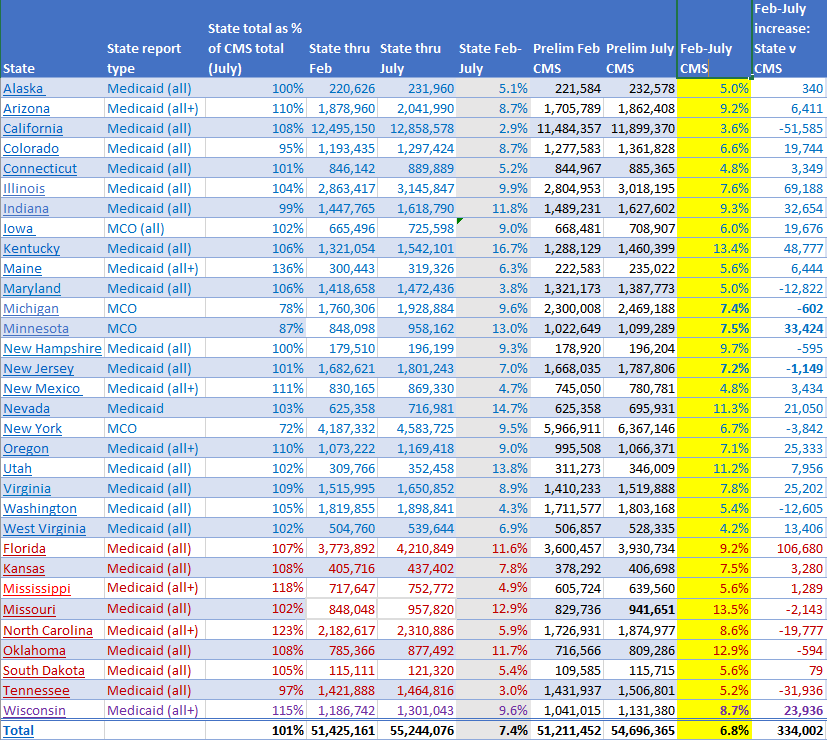I get commentary (in my emails) from xpostfactoid who writes on healthcare issues and also does a yeoman’s function not found else in reconciling ACA signups, the differences between the penalty-mandate vs no penalty-mandate, Medicaid signups by state in both expansion and non-expansion states, and lately the impact on Medicaid due to the Covid-19 pandemic. The data and commentary by xpostfactoid for this particular summary by me can be found here; State Medicaid enrollment totals in light of CMS’s (lagging) reports, November 27, 2020 Why track Medicaid numbers? As you well know, unemployment has increased since the start of the Covid-19 pandemic as a result of the shutdowns of businesses and government facilities. The resulting layoffs have caused many
Topics:
run75441 considers the following as important: Healthcare, Medicaid, xpostfactoid
This could be interesting, too:
Bill Haskell writes Families Struggle Paying for Child Care While Working
Joel Eissenberg writes RFK Jr. blames the victims
Joel Eissenberg writes The branding of Medicaid
Bill Haskell writes Why Healthcare Costs So Much . . .
I get commentary (in my emails) from xpostfactoid who writes on healthcare issues and also does a yeoman’s function not found else in reconciling ACA signups, the differences between the penalty-mandate vs no penalty-mandate, Medicaid signups by state in both expansion and non-expansion states, and lately the impact on Medicaid due to the Covid-19 pandemic. The data and commentary by xpostfactoid for this particular summary by me can be found here; State Medicaid enrollment totals in light of CMS’s (lagging) reports, November 27, 2020
Why track Medicaid numbers? As you well know, unemployment has increased since the start of the Covid-19 pandemic as a result of the shutdowns of businesses and government facilities. The resulting layoffs have caused many people to lose not only their healthcare but also their healthcare insurance. Two ways to qualify for healthcare insurance is on the healthcare exchanges which will still look at annual income or through state Medicaid which looks at “current” income. If you are laid off and have no income (or less than 100% FPL [unless your state says differently] or 138% FPL in expansion states0, you can qualify for Medicaid CMS’s monthly totals of state-by-state Medicaid enrollment growth during 202 as impacted by Covid-19 in 2020 is currently posted Medicaid.Gov through July reflecting:
- five months of enrollment as affected by the Covid-19 pandemic and
- four-plus months in which the suspension of disenrollment mandated by the Families First Act was in effect.
Most states post provisional Medicaid totals on state websites on a monthly basis and revise at varying intervals. xpostfactoid has been tracking Medicaid enrollment in 32 states in advance of CMS’s 2-3-month lag in Medicaid tracking numbers. To be redundant, the available state reports vary from the the CMS tabulations due to lagging CMS calculations. Both the state and the CMS numbers are adjusted retroactively. February-through-July presents a large enough sample (which xpostfactoid examines) to compare his monthly numbers the CMS numbers.
From February through July, in 32 states, xpostfactoid recorded a 7.4% increase in Medicaid enrollment. Since CMS has so far only released its preliminary report for July, an apples-to-apples February-July comparison requires using CMS’s preliminary rather than the updated February totals. With each month’s new preliminary report, CMS reports updates the prior month state-by-state totals, and the updated totals are higher as they include:
- retroactive enrollment and
- enrollees whose applications were not finalized in the prior month.
The February updated total is 405,491 higher than the preliminary February tally. Comparing the preliminary totals for both months, as CMS does here, suggests a 6.9% increase nationally from February-July, and 6.8% in the 32 states xpostfactoid tracks (see xpostfactoid’s chart below). Links to the state-issued reports are provided at bottom.
From January through June this year, CMS’s updated monthly total has exceeded the preliminary count by an average of 474,539 per month. The difference between xpostfactoid’s monthly estimates of the percentage increase and CMS’s official tallies, which lag by 2-3 months, accordingly may be
- narrower than 7.4% vs. 6.8% or,
- conversely wider.
The June increase in CMS’s updated total was just 273,117.
xpostfactoid: “The most recent published update to my 32-state sample derived from state-published supports suggests about 9.7% increase from February through September. Reducing the estimate proportionately to the July estimate would peg growth from February-September at 8.9%.”
 As to why some of the numbers are in red, I am not sure and will have to ask. If you go to xpostfactoid’s site, there is greater detail. I believe I have covered the important detail which is being relayed in my note here at AB. One important detail which xpostfactoid does not pronounce (the post is for other reasons) is the importance of Medicaid during this pandemic as many people have lost their healthcare insurance.
As to why some of the numbers are in red, I am not sure and will have to ask. If you go to xpostfactoid’s site, there is greater detail. I believe I have covered the important detail which is being relayed in my note here at AB. One important detail which xpostfactoid does not pronounce (the post is for other reasons) is the importance of Medicaid during this pandemic as many people have lost their healthcare insurance.
